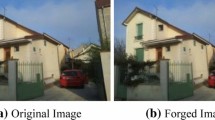Abstract
The growing need of digital software and media deals with the tampering of numerous multimedia data for mischievous determinations in case of broadcasting approaches. The supreme collective procedure of tampering linked with digital descriptions is copy–move forgery system that deals with a portion of duplicate image and replaced in diverse locations. Therefore, forensic authorities require consistent and effective means of sensing such maliciously forged data. Following study recommends a learning method for the detection of forgery. The image segmentation is the first step, in which the histogram of angled slopes is functional to every block followed by feature extraction; and concentrated to enable the dimension of resemblance. The detection is done using Support vector machines. The results establish that the projected process is intelligent to perceive various instances of copy–move forgery which are able to detect the duplicate regions.














Similar content being viewed by others
References
Al-Qershi OM, Khoo BE (2013) Passive detection of copy–move forgery in digital images: states-of-the-art. Forensic Sci Int 206(1):284–295
Amerini I, Ballan L, Caldelli R, Del Bimbo A, Serra G (2011) A SIFT-based forensic method for copy–move attack detection and transformation recovery. IEEE Trans Inf Forensics Secur 6:1099–1110
Bayram S, Husrev HT, Memon N (2009) An efficient and robust method for detecting copy–move forgery. In: Proceedings of the IEEE international conference on acoustics, speech and signal processing, pp 1053–1056
Chen L, Lu W, Ni J, Sun W, Huang J (2013) Region duplication detection based on Harris corner points and step sector statistics. J Vis Commun Image Represent 24:244–254
CoMoFoD Database. <http://www.vcl.fer.hr/comofod>
Costanzo A, Amerini I, Caldelli R, Barni M (2014) Forensic analysis of SIFT keypoint removal and injection. IEEE Trans Inf Forensics Secur 9(9):1450–1464
Dalal N, Triggs B (2005) Histograms of oriented gradients for human detection. CVPR:20–25
Fridrich J (1999) Methods for tamper detection in digital images. In: Proceedings of the ACM workshop on multimedia and security, pp 19–23
Fridrich J, Soukal D, Lukas J (2003) Detection of copy–move forgery in digital images. In: proceedings of digital forensic research workshop, pp 19–23
Gloe T, Kirchner M, Winkler A, Behme R (2007) Can we trust digital image forensics? In: Proceedings of the 15th international conference on multimedia, pp 78–86
Kang X, Wei S (2008) Identifying tampered regions using singular value decomposition in digital image forensics. In: Proceedings of international conference on computer science and software engineering, pp 926–930
Khan S, Kulkarni A (2010) An efficient method for detection of copy–move forgery using discrete wavelet transform. Int J Comput Sci Eng 2:1801–1806
Li L, Li S, Zhu H (2013) An efficient scheme for detecting copy–move forged images by local binary patterns. JIHMSP 4:46–56
Li L, Li S, Zhu H, Wu X (2014) Detecting copy–move forgery under affine transforms for image forensics. Comput Electr Eng 40:1951–1962
Lowe D (1999) Object recognition from local scale-invariant features. ICCV 2:1150–1157
Luo W, Huang J, Qiu G (2006) Robust detection of region duplication forgery in digital image. In: Proceedings of the 18th international conference on pattern recognition, vol 4. pp 746–749
Luo W, Qu Z, Pan F, Huang J (2009) A survey of passive technology for digital image forensics. FCSC 1:308–322
Lynch G, Shih FY, Liao HM (2013) An efficient expanding block algorithm for image copy–move forgery detection. Inf Sci 239:253–265
Mahdian B, Saic S (2007) Detection of copy–move forgery using a method based on blur moment invariants. Forensic Sci Int 171:180–189
Pan X, Lyu S (2010) Region duplication detection using image feature matching. IEEE Trans Inf Forensics Secur 4:857–867
Popescu A, Farid H (2004) Exposing digital forgeries by detecting duplicated image regions. Technical Report TR2004–515, Department of Computer Science, Dartmouth College
Author information
Authors and Affiliations
Corresponding author
Additional information
Publisher’s Note
Springer Nature remains neutral with regard to jurisdictional claims in published maps and institutional affiliations.
Rights and permissions
About this article
Cite this article
Parashar, A., Upadhyay, A.K. & Gupta, K. An effectual classification approach to detect copy-move forgery using support vector machines. Multimed Tools Appl 78, 29413–29429 (2019). https://doi.org/10.1007/s11042-018-6707-9
Received:
Revised:
Accepted:
Published:
Issue Date:
DOI: https://doi.org/10.1007/s11042-018-6707-9




